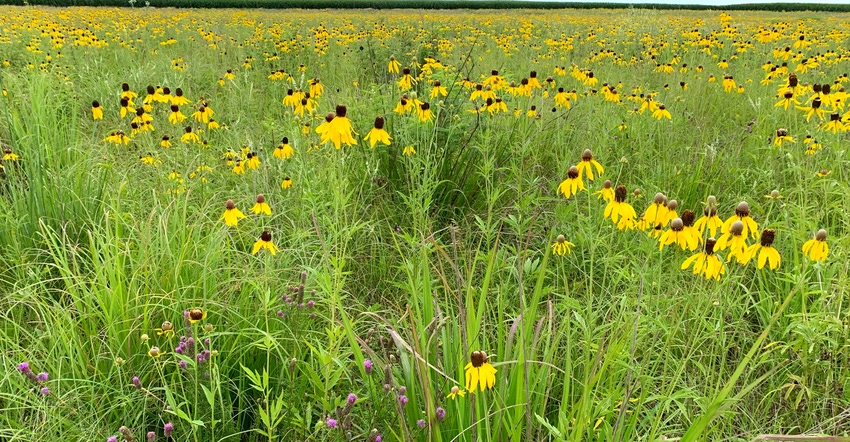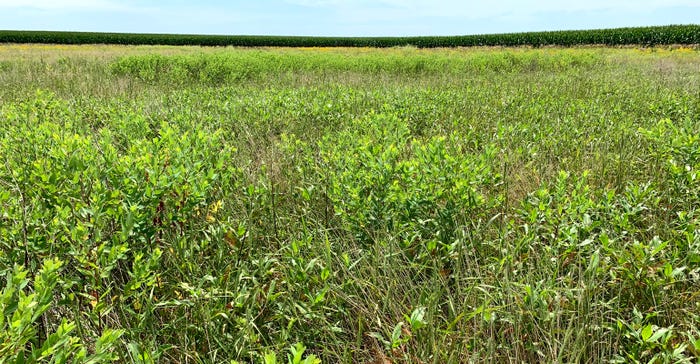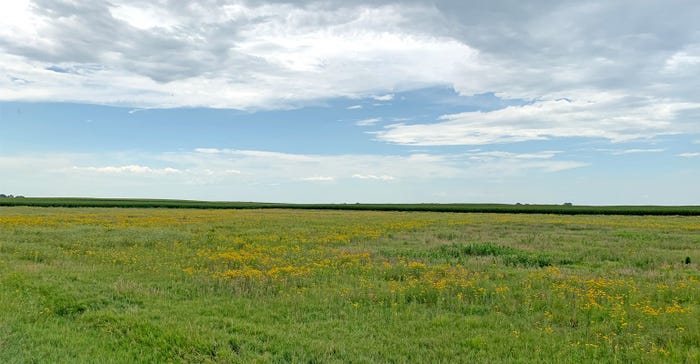November 20, 2020

Much progress has been made in edge-of-field conservation practices over the past decade. Structures such as bioreactors and saturated buffers have proven to reduce nitrate levels in subsurface drainage water and help keep nutrients out of downstream waterways. Other strategies include planting prairie strips and promoting perennial vegetation to reduce nutrient levels in water.
These practices can be looked at as barriers to nitrate loss when established between row crop fields and waterways. These practices tend to be located at borders of fields and waterways. Broadening the scope of where a field edge is to be found can expand the opportunities for these practices to add value.
In locating and defining the boundaries of sub-field areas that may have lower productivity, a new field edge definition emerges. Frequently, such low productivity areas occur in depressions and prairie potholes that tend to retain water longer, a situation seldom conducive to crop health.
Mark Licht, Iowa State University Extension cropping systems specialist, has been working with multiple research teams to better understand how edge-of-field practices can be used in ways that will boost profitability for farmers while helping make progress toward conservation goals. Referring to a recent report on the North Central Region Sustainable Ag Research and Education (SARE) field study, Licht notes some positive trends and challenges to expanding the definition of field edge and using perennial plantings.
Focus on unprofitable acres
Planting perennial grasses and forbs in unprofitable areas of fields can:
• reduce erosion and nitrate leaching
• provide forage and habitat for wildlife
• reduce input costs for farmers
• improve water infiltration
• increase biomass
• contribute to soil health
“In looking for opportunities to redefine the field edge,” Licht says, “we are finding on the whole, underproducing areas within a field, which tend to be wet for extended periods during the row crop season, are being subsidized by the performance of the remainder of the field, which may be yielding at or above par.”

Researchers using various inputs and data resources are gaining confidence in the ability to help farmers carve out low-productivity areas of fields where it would be better to plant perennials instead of corn and soybeans. The analytic process uses yield data from spatial data files provided by the farmers using SMS Advanced software. Farm management practices reported by participating farmers are also considered to get the best understanding of local dynamics.
To determine profit and loss, the team applied National Agricultural Statistics Service commodity prices and ISU Extension cost of production for the given year. These data sets provide accurate estimates with respect to the field and cropping system but hold anonymous the profit-and-loss profile for individual farms.
“We ran a subfield profitability analysis to identify the low-productivity areas based on the data,” Licht says. “When we shared the results with the farmers, they agreed with the findings. Arriving at the same conclusions regarding low-producing areas through farmer experience and data analytics helped to validate the process.”
Save money, don’t plant these areas
An immediate input cost savings can be realized when the identified areas that are producing low corn and soybean yields are converted to perennials. Programming of planters and sprayers to skip these areas is a relatively simple practice. However, more analysis is needed to project long-term and sustainable contribution to profitability from forage or other uses of perennial areas, so there is potential for more positive returns.
In typical edge-of-field applications, converting from row crops to perennials is relatively simple. Long prairie strips, end rows and borders are easy to identify and manage. Subfield areas may require more effort to work around, but stemming the loss associated with poor or no yield should make it worth considering.
Through listening sessions and surveys, input on perennial plantings was also gathered from farmers. Both challenges and benefits emerged from their input. The challenges cited are:
• Flooding can damage perennials as well as row crops.
• Invasive species must be prevented from crowding out more desirable plants.
• Herbicide drift can harm the perennial forage.
• There is limited access to information for growers
• Perennials involve the expenses to plant and maintain.
The benefits of perennial seedings include:
• increased populations of pollinators such as bees and monarch butterflies
• greater hunting and birdwatching opportunities
• more varieties and higher populations of bird
• expected erosion control, nitrate management and soil health
Still more to be learned
Next steps by researchers include a study of established depression areas of fields to assess what species of grasses and forbs exist and flourish. They’ll also study wildlife supported by habitat in these areas, and what extended benefits apply to crops and the farm through such things as greater pollinator populations promoted by the habitats.
“Educational materials and opportunities are some of the most important next steps to promote conversion of low-productivity subfield areas to perennials,” Licht says. “Farmers want to see case studies and proof that the theory works in practice. And the researchers want to see broad adoption to help increase data volume for analysis.”

Key areas being explored include assessment of different combinations of grasses and forbs that can be best tuned to a location. Further soil health studies to document water infiltration are needed, and to measure biomass and better understand nitrate management, and recommendations on field management and perennial maintenance. In addition, case studies will be written to help educate farmers on the balance of using conservation practices and row crop activities that can maximize profitability while making positive impacts on the environment.
Applying practices known to be successful at the traditional edge-of-row crop fields to less traditional subfield areas can deliver economic and environmental benefits. This new definition for the field edge is taking root and should prove to be an opportunity to learn and expand the application of these practices.
Ripley is an Iowa Learning Farms conservation outreach specialist.
About the Author(s)
You May Also Like




